1st Position Blues Harp – An Introduction (Part 4)
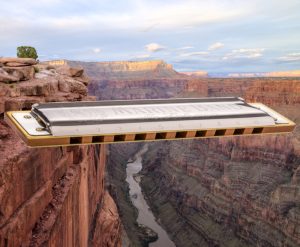 The Grand Canyon which yawns between the writer’s concept of what he wants to capture in words and what comes through is a cruel abyss.
The Grand Canyon which yawns between the writer’s concept of what he wants to capture in words and what comes through is a cruel abyss.
— Fannie Hurst
Welcome to the final leg of our journey into 1st position blues technique. In previous posts we considered why 1st position blues can sometimes be left in the shadows. We also touched on building a general awareness of positional playing, how some positions are interchangeable, the Ionian Mode, the low end 1st position blues scale, and some low and high end 1st position signature licks.
As our versatility in 1st position grows, an inherent problem soon emerges; there’s not much on offer in the middle octave, so it’s difficult to connect holes 1 to 10 fluently using the blues scale. Consequently a common feature of 1st position blues involves jumping back and forth between the lower and upper ends of the harp.
In the middle register, the 1st position blues scale is buried in some uncomfortable overbends. For many players these are unachievable, which is why they’re left with such a meagre musical menu. Examples of licks played between holes 4B and 7B are few and far between, and the content is usually unsubstantial. Nonetheless, let’s see if we can shed some light on this time-worn enigma
Crossing the great divide
In this, part 4 of our guide to 1st position blues harping, we will explore:
• Bridging the middle octave
• Some handy little extras
Where did my blues scale disappear to?
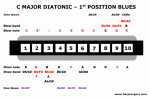 Let’s remind ourselves of the C blue scale. Our notes are C Eb F F# G Bb C . In the middle octave of a C harmonica this translate into 4B 4B# 5D 5B# 6B 6B# 7B . The tab symbol # indicates an overbend and so the middle register requires a total of three overblows to complete the blues scale. This is an advanced skill and many players will be ill-equipped to traverse the gap. Some would argue that the quality of overbent notes is not entirely gratifying in any case. And so the middle register remains a wasteland. It’s a shame because each of the overblows is a very useful tone in the blues dialect. On a C harp 4B# is the flat 3rd (Eb), 5B# is the flat 5th (F#), and 6B# is the flat 7th (Bb). Ultimately our options are binary: we can walk away or, to quote Shakespeare’s Hamlet, ‘take Arms against a Sea of troubles, And by opposing end them’.
Let’s remind ourselves of the C blue scale. Our notes are C Eb F F# G Bb C . In the middle octave of a C harmonica this translate into 4B 4B# 5D 5B# 6B 6B# 7B . The tab symbol # indicates an overbend and so the middle register requires a total of three overblows to complete the blues scale. This is an advanced skill and many players will be ill-equipped to traverse the gap. Some would argue that the quality of overbent notes is not entirely gratifying in any case. And so the middle register remains a wasteland. It’s a shame because each of the overblows is a very useful tone in the blues dialect. On a C harp 4B# is the flat 3rd (Eb), 5B# is the flat 5th (F#), and 6B# is the flat 7th (Bb). Ultimately our options are binary: we can walk away or, to quote Shakespeare’s Hamlet, ‘take Arms against a Sea of troubles, And by opposing end them’.
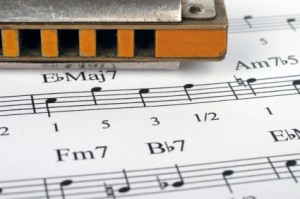 If the first option is your choice, be traditional but try to identify songs that suit 1st position best. Question any habitual recourse to 2nd position and you’ll be in for some very special 1st position moments. If you’re ready to explore the second option however, well done for taking up the gauntlet. We won’t spend time on overbending technique in this post, however you can investigate things for yourself in our Harp Skills section and online. It’s an advanced level of harping, which may require special gapping of your reeds and weeks of training. Don’t let this put you off though. Contemporary players consider overbending an essential skill that should be embraced rather than dodged.
If the first option is your choice, be traditional but try to identify songs that suit 1st position best. Question any habitual recourse to 2nd position and you’ll be in for some very special 1st position moments. If you’re ready to explore the second option however, well done for taking up the gauntlet. We won’t spend time on overbending technique in this post, however you can investigate things for yourself in our Harp Skills section and online. It’s an advanced level of harping, which may require special gapping of your reeds and weeks of training. Don’t let this put you off though. Contemporary players consider overbending an essential skill that should be embraced rather than dodged.
Blues Overtook Me
Let’s begin by checking the basic ‘tonal bridge’ that connects the two sides of our musical chasm, and whether it’s of practical value. From the scale outlined above, our bend-free pathway is 4B 5D 6B 7B . In which case things appear very limited.
 In his song Blues Overtook Me, Charlie Musselwhite charts these notes, albeit with an interesting added dimension. In the clip below we have picked out fragments from the versions in his 2008 Rough Dried – Live At The Triple Door album, and subsequent 2012 Juke Joint Chapel album. In both cases, Charlie is playing 1st position on a G harp. For expediency he also includes 5B, which echoes the idiosyncrasies of 2B played in the lower register of 1st position blues (our ‘blues wannabe’ note). Charlie’s phrase is 6B 5B 5D 5B 4B, and it’s tucked in just before the song shifts to the V chord with its associated 2nd position options. Try it out.
In his song Blues Overtook Me, Charlie Musselwhite charts these notes, albeit with an interesting added dimension. In the clip below we have picked out fragments from the versions in his 2008 Rough Dried – Live At The Triple Door album, and subsequent 2012 Juke Joint Chapel album. In both cases, Charlie is playing 1st position on a G harp. For expediency he also includes 5B, which echoes the idiosyncrasies of 2B played in the lower register of 1st position blues (our ‘blues wannabe’ note). Charlie’s phrase is 6B 5B 5D 5B 4B, and it’s tucked in just before the song shifts to the V chord with its associated 2nd position options. Try it out.
Many years ago when we asked Charlie what he does to cross the ‘canyon’ in 1st position blues, his response was, ‘you just see what comes next or what sounds right to you, then start at the top. Get some practice in no-mans-land. Find out what works with you.’
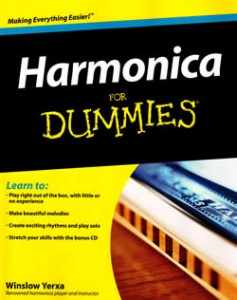 In his excellent book Harmonica For Dummies, on track 79 First Position blues in the top & bottom registers (tabbed on page 216), Winslow Yerxa also sets foot on our 1st position tonal bridge as part of his transition from the top to bottom end of a C harp. You can hear him cover the useful notes we’ve identified at the start of the clip and again as the next 12 bar sequence start. His phrase 4B 5B 5D 5B..4B is not dissimilar in shape to the riff from Billy Boy Arnold’s Eldorado Cadillac, albeit with the major rather than minor third in 5B, which again echoes 2B lower down.
In his excellent book Harmonica For Dummies, on track 79 First Position blues in the top & bottom registers (tabbed on page 216), Winslow Yerxa also sets foot on our 1st position tonal bridge as part of his transition from the top to bottom end of a C harp. You can hear him cover the useful notes we’ve identified at the start of the clip and again as the next 12 bar sequence start. His phrase 4B 5B 5D 5B..4B is not dissimilar in shape to the riff from Billy Boy Arnold’s Eldorado Cadillac, albeit with the major rather than minor third in 5B, which again echoes 2B lower down.
The full Monty
To increase our musical effectiveness in the middle range, let’s begin by introducing the flat 3 (Eb on a C harp), which is the overblow in 4B#. Here’s a sequence you may like to try
2D”..2D 3D’..2D..3D’..4B 4B#..4B..3D’..2D 2D’..2D”..2B..1B…
Now let’s add our next useful tone, the flat 7 (Bb on a C harp), which is the overblow in 6B#. We’ll build on the sequence above like so:
2D”..2D 3D’..2D..3D’..4B 4B#..5D..6B..6B#
And finally let’s introduce the flat 5 (F# on a C harp), which is the overblow in 5B#. Connected to the suspended octave root in 7B, this is a very powerful blues tone:
7B..5B# 5D….4B#..4B
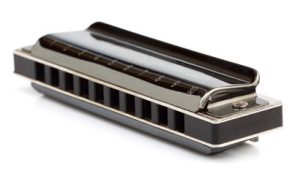 Can we fix the blues wannabe note in 2B?
Can we fix the blues wannabe note in 2B?
Notice how integral the 4B# flat 3rd is to each of the phrases illustrated. This should be telling us something right? Firstly it makes a useful addition to our tonal pallet. Secondly, shouldn’t we be looking to do the same thing on the 1B# in order to correct the tonal issue in 2B?
Well, yes and no. In some respects the 2B tone is what has given established low end phrases in 1st position blues their unique quality. In other respects, and on a technicality, if you can play the 1B# then good luck to you. Even the top players will tell you its a beast to play, even on high tunings of harmonica.
And on that final point, here’s the closing dilemma. If you want to make life easier for yourself playing the high end blow bends in 1st position blues, you’ll no doubt choose a low tuning of harmonica; typically Bb or below. In which case the chances of producing a 1B# are reduced even further. To an extent, using a lower tuning of harp may also affect some player’s capability of activating one or two of the central overbends we’ve been exploring. On a G harp, for example, the high end blow bends play like a dream. The 6B# also seems to be readily available. However, the 4B# and 5B# are generally much less cooperative. Meanwhile the 1B# remains the stuff of fantasy. So go with what each harp offers, but put some time into expanding your 1st position blues knowledge and payload as well.
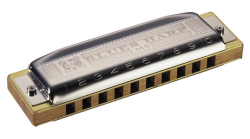 Just for the trill of it
Just for the trill of it
Now if all this overbending stuff has left you feeling a bit ragged, let’s close the series with something a little more manageable. Back to the top end. It’s a 1st position trill we hear quite often, which can be sustained for a number of bars and you can comfortably drop it into your top end work. Played on a G harp, here it is in isolation and then as part of a top end phrase.
~[8B~9B]…..[8B’~9B’]…..[8B~9B]…..
You’ll notice the clip above also has a closing phrase which starts with 10B played with tongue vibrato. Check out our Key Skills menu for vibrato technique and contact us if you’d like some one to one coaching.
And now on your A harp, a bonus lick. It’s a favourite entry point for top end blow bend sequences. The clip is followed by a phrase ending with the same lick.
9B..9B’..8B’~
9B ~10B..~10B..~10B..~10B 9B..10B..10B” 9B..9B’..8B’~
Signing off
To round everything off, hold on to your A harp and join in with Kim Wilson on the Fabulous Thunderbirds’ rendition of You’re Humbuggin’ Me. You’ll need your listening head on as there is some fine intonation needed to compliment the chord changes.
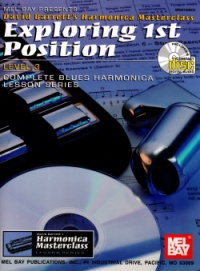 I can’t do my homework any more
I can’t do my homework any more
Check out Dave Barrett’s book on Exploring 1st Position. It has a heap of practice riffs to work through that will develop your bending muscles! Dave also has books which cover 2nd and 3rd position. We also recommend Winslow Yerxa’s book Harmonica For Dummies as a neat way of exploring this feature of the diatonic harp. Check out our Music Store page for all these books. You can also explore numerous excellent YouTube tutorials on this topic by Jason Ricci.
Associated posts:
1st Position Blues Harp – An Introduction (Part 1)
1st Position Blues Harp – An Introduction (Part 2)
1st Position Blues Harp – An Introduction (Part 3)


Thanks, I was surprised to see that you made good on your promise to fill this 1st position gap so quickly.